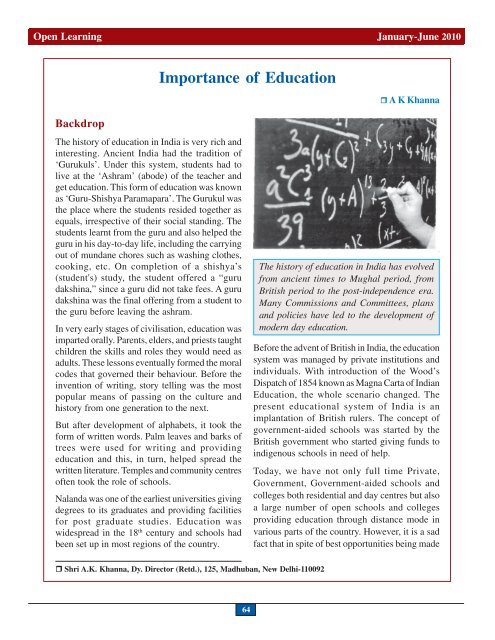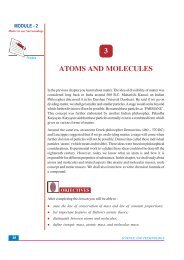Open Learning Jan-June -2010 - An Awareness Magazine
Open Learning Jan-June -2010 - An Awareness Magazine
Open Learning Jan-June -2010 - An Awareness Magazine
Create successful ePaper yourself
Turn your PDF publications into a flip-book with our unique Google optimized e-Paper software.
eqDr <strong>Open</strong> f'k{kk <strong>Learning</strong> <strong>Jan</strong>uary-<strong>June</strong> tuojh&twu <strong>2010</strong><br />
Importance of Education<br />
A K Khanna<br />
Backdrop<br />
The history of education in India is very rich and<br />
interesting. <strong>An</strong>cient India had the tradition of<br />
‘Gurukuls’. Under this system, students had to<br />
live at the ‘Ashram’ (abode) of the teacher and<br />
get education. This form of education was known<br />
as ‘Guru-Shishya Paramapara’. The Gurukul was<br />
the place where the students resided together as<br />
equals, irrespective of their social standing. The<br />
students learnt from the guru and also helped the<br />
guru in his day-to-day life, including the carrying<br />
out of mundane chores such as washing clothes,<br />
cooking, etc. On completion of a shishya’s<br />
(student's) study, the student offered a “guru<br />
dakshina,” since a guru did not take fees. A guru<br />
dakshina was the final offering from a student to<br />
the guru before leaving the ashram.<br />
In very early stages of civilisation, education was<br />
imparted orally. Parents, elders, and priests taught<br />
children the skills and roles they would need as<br />
adults. These lessons eventually formed the moral<br />
codes that governed their behaviour. Before the<br />
invention of writing, story telling was the most<br />
popular means of passing on the culture and<br />
history from one generation to the next.<br />
But after development of alphabets, it took the<br />
form of written words. Palm leaves and barks of<br />
trees were used for writing and providing<br />
education and this, in turn, helped spread the<br />
written literature. Temples and community centres<br />
often took the role of schools.<br />
Nalanda was one of the earliest universities giving<br />
degrees to its graduates and providing facilities<br />
for post graduate studies. Education was<br />
widespread in the 18 th century and schools had<br />
been set up in most regions of the country.<br />
The history of education in India has evolved<br />
from ancient times to Mughal period, from<br />
British period to the post-independence era.<br />
Many Commissions and Committees, plans<br />
and policies have led to the development of<br />
modern day education.<br />
Before the advent of British in India, the education<br />
system was managed by private institutions and<br />
individuals. With introduction of the Wood’s<br />
Dispatch of 1854 known as Magna Carta of Indian<br />
Education, the whole scenario changed. The<br />
present educational system of India is an<br />
implantation of British rulers. The concept of<br />
government-aided schools was started by the<br />
British government who started giving funds to<br />
indigenous schools in need of help.<br />
Today, we have not only full time Private,<br />
Government, Government-aided schools and<br />
colleges both residential and day centres but also<br />
a large number of open schools and colleges<br />
providing education through distance mode in<br />
various parts of the country. However, it is a sad<br />
fact that in spite of best opportunities being made<br />
Shri A.K. Khanna, Dy. Director (Retd.), 125, Madhuban, New Delhi-110092<br />
64
















